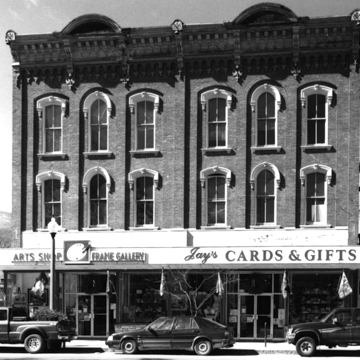You are here
Park Block (Drysdale's Department Store)
Despite street-level alterations, the upper floors of this block remain one of the most elaborate statements of Civil War–era commercial architecture in Vermont. They pre sent a visual tour de force of brick panels within panels, windows with alternating segmental-and round-headed hood moldings, a corbeled arcade accented with inverted fleurdelis pendants, and an ornate bracketed wood cornice carrying a pair of segmental pediments. Although more fussily decorative, the building's basic design features are similar to those of the Merchants' Bank in North Bennington (1864–1865), which was commissioned by the same patron, Trenor W. Park. This suggests that the Park Block is also by Diaper and Dudley, the architects of Park's North Bennington projects. Its vocabulary is also consistent with that of the striking Pennysaver Building next door, which had been built as the Bennington County Courthouse (1870), now shorn of its elaborate porch and mansard-roofed clock tower. This may indicate that the New York City architects were involved in that undertaking as well.
The Park Block was acquired in 1906 as the fourth and final home of Drysdale's Department Store, which remained in business until the 1970s and was responsible for the remodeled ground-floor storefronts. In 1976, federal grants led to the removal of a metal-screen false front on the courthouse and the restoration of the facade of the neighboring Putnam Hotel of 1870 to its north. These returned to South Street something of the block's original Italianate character and urbanistic unity.
Writing Credits
If SAH Archipedia has been useful to you, please consider supporting it.
SAH Archipedia tells the story of the United States through its buildings, landscapes, and cities. This freely available resource empowers the public with authoritative knowledge that deepens their understanding and appreciation of the built environment. But the Society of Architectural Historians, which created SAH Archipedia with University of Virginia Press, needs your support to maintain the high-caliber research, writing, photography, cartography, editing, design, and programming that make SAH Archipedia a trusted online resource available to all who value the history of place, heritage tourism, and learning.









